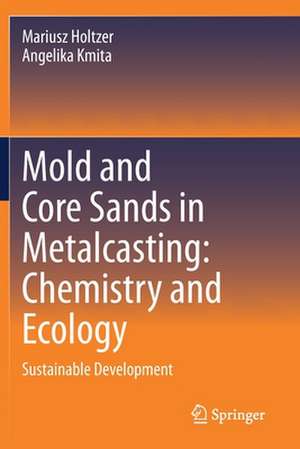Mold and Core Sands in Metalcasting: Chemistry and Ecology: Sustainable Development
Autor Mariusz Holtzer, Angelika Kmitaen Limba Engleză Paperback – 20 sep 2021
- Describes the mechanisms of hardening and thermal destruction of individual binders in moulding and core sands;
- Assesses the influence of moulding and core sands technology on the environment;
- Discusses state of the art moulding and core sand technology.
| Toate formatele și edițiile | Preț | Express |
|---|---|---|
| Paperback (1) | 645.14 lei 6-8 săpt. | |
| Springer International Publishing – 20 sep 2021 | 645.14 lei 6-8 săpt. | |
| Hardback (1) | 649.87 lei 3-5 săpt. | |
| Springer International Publishing – 19 sep 2020 | 649.87 lei 3-5 săpt. |
Preț: 645.14 lei
Preț vechi: 758.99 lei
-15% Nou
Puncte Express: 968
Preț estimativ în valută:
123.44€ • 128.90$ • 101.94£
123.44€ • 128.90$ • 101.94£
Carte tipărită la comandă
Livrare economică 15-29 aprilie
Preluare comenzi: 021 569.72.76
Specificații
ISBN-13: 9783030532123
ISBN-10: 3030532127
Ilustrații: XXIX, 359 p. 335 illus., 59 illus. in color.
Dimensiuni: 155 x 235 mm
Greutate: 0.55 kg
Ediția:1st ed. 2020
Editura: Springer International Publishing
Colecția Springer
Locul publicării:Cham, Switzerland
ISBN-10: 3030532127
Ilustrații: XXIX, 359 p. 335 illus., 59 illus. in color.
Dimensiuni: 155 x 235 mm
Greutate: 0.55 kg
Ediția:1st ed. 2020
Editura: Springer International Publishing
Colecția Springer
Locul publicării:Cham, Switzerland
Cuprins
Chapter 1. Introduction.- Part I. Organic Chemistry.- Chapter 2. General Principles of Organic Chemistry.- Chapter 3. Synthetic Resins.- Part II. Organic Binder Systems of Molding and Core Sands.- Chapter 4. Aggregate Molding Materials.- Chapter 5. Division of the Molding and Cores Sands – Criterions.- Chapter 6. Cold - Setting Processes.- Chapter 7. Gas Hardened Processes.- Chapter 7. Heat Curing Processes.- Part III. Inorganic Binder Systems of Molding and Core Sands and Protective Coatings.- Chapter 9. Sodium Silicate Molding Sands.- Chapter 10. Green Sands.- Chapter 11. Other Molding And Cores Sands With Inorganic Binders.- Chapter 12. Protective Coatings for Mold and Core Sands.- Part IV. Special Technologies of Making Molds and Cores.- Chapter 13. Alternative Methods Using in Mold and Cores Technologies.- Part V. Environmental Aspects Mold and Core Technologies.- Chapter 14. Influence of the Technologies of Molding and Core Sands on the Environment and Working Conditions – Summary.
Notă biografică
Dr. Mariusz Holtzer is a full professor at AGH University of Science and Technology in Krakow, Poland. His research focuses on physical chemistry of metallurgical and foundry phenomenon on the interface of the liquid metal - ceramic material and metallurgical slag. He is also involved in researching the impact of the foundry industry on the environment, with a special focus on waste management, hazard evaluation of materials, and quality assessment of moulding and core sands. He is the author or co-author of 300 scientific papers, the co-author on 14 patents, and represents Poland in Commission No. 2 Environmental Protection of CAEF (The European Foundry Association).
Dr. Angelika Kmita is a assistant professor at AGHUniversity of Science and Technology, Krakow, Poland. Her research focuses on design, synthesis and characterization of hybrid nanoparticles and nanocomposites, as well as environmental concernsin the foundry industry. She is the author or co-author of 45 scientific papers, the co-author of 3 monographs, and the co-author of 3 patents. She represents Poland in COST (European Cooperation in Science & Technology) as MC substitute in Action CA18125 .
Dr. Angelika Kmita is a assistant professor at AGHUniversity of Science and Technology, Krakow, Poland. Her research focuses on design, synthesis and characterization of hybrid nanoparticles and nanocomposites, as well as environmental concernsin the foundry industry. She is the author or co-author of 45 scientific papers, the co-author of 3 monographs, and the co-author of 3 patents. She represents Poland in COST (European Cooperation in Science & Technology) as MC substitute in Action CA18125 .
Textul de pe ultima copertă
The metal casting, uses large amounts of natural resources, energy and metals as well as generates significant amounts of gases and solid wastes, which have an essential influence on the natural environment and work conditions in casting houses. The condition of the further development is the adjustment to the strategy of the sustainable development.This book examines potential solutions to the economic, ecological, and occupational hazards generated by the foundry industry. It focuses on emissions of chemical compounds during the preparation and formation of molding sands, molds pouring with molten metal, molds cooling and castings knocking out. It also addresses the effects of the spent molding sands reclamation process and the influence of spent sands on the environment during their storage. Establishing the most sustainable techniques for limiting the negative impact of foundry processes on the environment is explored in detail. The book will be valuable toacademics and industry professionals alike.
- Describes the mechanisms of hardening and thermal destruction of individual binders in moulding and core sands;
- Assesses the influence of moulding and core sands technology on the environment;
- Discusses state of the art moulding and core sand technology.
Caracteristici
Describes the mechanisms of hardening and thermal destruction of individual binders in moulding and core sands Assesses the influence of moulding and core sands technology on the environment Discusses state of the art moulding and core sand technology
